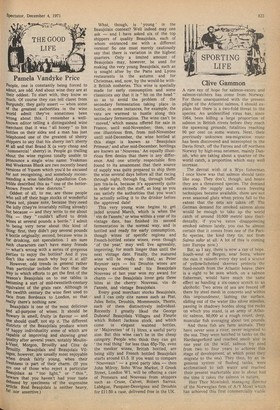Pamela Vandyke Price
People, one is constantly being forced to admit, are odd. And about wine they are at their oddest. To start with, they know so Much. Of course they can tell claret from Burgundy, they gaily assert — when some Of the greatest authorities in the wine World admit they've sometimes been Wrong about this. I remember a wellknown editor telling a distinguished wine merchant that it was "all hooey" to bin bottles on their sides and a man has just telephoned one of the greatest of sherry Shippers to say that his sherry isn't sherry at all and that Brand X (a very cheap and ' commercial ' sherry) is. People go trailing about the wine regions totally unable to Pronounce a single wine name: Yeakman and Weekman Blank are two recently heard Versions of Yquem which you'd be excused for not recognising, and somebody recommending a wine labelled Appellation Controlee described this as "one of the betterknown French wine districts."
Oddest of all, to me, are those people Who sell off their huge stocks of wonderful Wines not, please note, because they .need the lolly (they're invariably rolling already) but because — and they write to me about this — they "couldn't afford to drink Wines at several pounds a bottle." I admit to being very terse about this kind of thing: first, they didn't pay several pounds a bottle originally; second, because wine is for drinking, not speculation. I am sure such characters can't have many friends what's wrong with a series of gorgeous Parties to enjoy the bottles? And if you don't like wine much why buy it at all?
However, odd trends in general rather than particular include the fact that the Way in which efforts to get the first of the season's Beaujolais on to our tables is becoming a sort of mid-twentieth-century equivalent of the grain race. Although in the twelfth century the wine fleet used to race from Bordeaux to London, so that really there's nothing new. Beaujolais is one of the most delicious and all-purpose of wines. It should be flowery in smell, fruity in flavour — and one should quaff, not sip it. The different districts of the Beaujolais produce wines Of happy individuality some of which are capable of improving and showing great quality after several years, notably Moulina-Vent, Morgon, Brouilly and C6te de Brouilly. Beaujolais and Beaujolais Villages, however, are usually most enjoyable When drunk fairly young, when their freshness is part of their charm. (If you re one of those who reject a particular deaujolais as " too light," or "thin ", b.eware that you haven't had your taste debased by specimens of the ungenuine ride. Real Beaujolais is neither heavy,
nor assertive.) What, though, is ' young ' in the Beaujolais context? Well indeed may one ask — and I have asked six of the top shippers of quality Beaujolais, each of whom entranced me with a different version! So one must merely cautiously say that there is variation in the highest quarters. Only a limited amount of Beaujolais may, however, be used for making the very young Beaujolais, such as is sought after by the Paris and Lyons restaurants in the autumn and for Christmas, and, now, by the would-be withit British nosheries. This wine is specially made for early consumption and some classicists say that it is " hit on the head " so as to avoid the problem of the secondary fermentation taking place in bottle; in some instances, for example, the vats are warmed to hustle along this secondary fermentation. The wine can't be 'moved,' which means offered for sale in France, until mid-November; then, says one illustrious firm, from mid-November until mid-December, the wine bottled at this stage is known as Beaujolais Primeur,' and after mid-December, bottlings are known as 'Nouveau.' An equally illustrious firm denies that there is any difference. And one utterly respectable firm found to its amazement that their source of supply was quite prepared to ship them the wine several days before all that racing through night, through fog, through traffic jam tra-la-la, because it's apparently quite in order to shift the stuff, as long as you can satisfy the authorities that you won't be actually selling it to the drinker before the approved date!
This very young wine begins to get jaded around March, which is when the 'yin de l'annee,' or wine within a year of its vintage date, has finished its second fermentation in the normal way, and is bottled and ready for early consumption, though wines of specific regions and French-bottled estate wines, even though 'of the year,' may well live agreeably, improving, for much longer than until the next vintage date. Finally, the matured wine will be ready, so that, as Peter Reynier says — his Drouhin wines are always excellent• and his Beaujolais Nouveau of last year won my award for charm — the Beaujolais lover gets three bites at the cherry: Nouveau, yin de l'annee, and vintage Beaujolais.
Every good merchant stocks Beaujolais, and I can only cite names such as Piat, Jules Belin, Drouhin, Mommessin, Thorin, each of them distinctively individual. Recently I greatly liked the George Duboeuf Beaujolais Villages and Fleurie which Robert Jackson stock, and which come in elegant waisted bottles, or ' Majorettes ' of 11 litres, a useful party size. But this wine can't be in the cheap category. People who think they can get 'the real thing ' for less than 65p-75p, even the meeker wines, British bottled, are being silly and French bottled Beaujolais starts around 61.5. If you want to compare 'Nouveaux' — a good party idea — then John Milroy, Soho Wine Market, 3 Greek Street, London WI, will be offering a case of Primeurs and Nouveau from shippers such as Cruse, Calvet, Robert Sarrau, Labegue, Pasquier-Desvignes and Drouhin for 611.50 a case, delivered free in the UK.










































 Previous page
Previous page